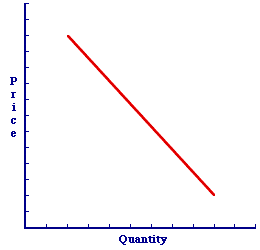
|
|
MARKET POWER: The ability of buyers or sellers to exert influence over the price or quantity of a good, service, or commodity exchanged in a market. Market power largely depends on the number of competitors on each side of the market. If a market has relatively few buyers, but many sellers, then limited competition on the demand-side of the market means buyers tend to have relatively more market power than sellers. The converse occurs if there are many buyers, but relatively few sellers. This is also termed market control.
Visit the GLOSS*arama
|
|


|

|
                           BUYERS' INCOME, DEMAND DETERMINANT: The income that buyers have available to purchase a good, which is assumed constant when a demand curve is constructed. Buyers' income is one of five demand determinants that shift the demand curve when they change. The other four are buyers' preferences, other prices, buyers' expectations, and number of buyers. Buyers' income affects the ability to purchase a good. In general, income has a direct affect on the ability to buy a good, that is, more income means more buying. However, income can actually affect demand in two ways. For normal goods, more income means more demand. For inferior goods, however, more income means less demand.Normal and InferiorWhen it comes to the buyers' income demand determinant, goods fall into one of two types--normal and inferior.- Normal Good: A normal good exists when buyers are inclined to buy more of the good if they have more income. A normal good is so named because it represents the typical, or "normal" situation. An increase in income means buyers have a greater ability to purchase goods. As such, buyers are "normally" inclined to buy more if they have more income.
- Inferior Good: An inferior good exists when buyers are inclined to buy less of the good if they have more income. An inferior good is so named because it tends to be less expensive than more desirable goods. As such, when buyers have more income and can afford to buy the more expensive products, then they reduce their purchases of the inferior goods.
Shifting the Demand Curve| Buyers' Income | 
|
A change in buyers' income causes the demand curve to shift. This can be illustrated using the negatively-sloped demand curve for Wacky Willy Stuffed Amigos presented in this exhibit. This demand curve captures the specific one-to-one, law of demand relation between demand price and quantity demanded. Buyers' income is assumed to remain constant with the construction of this demand curve.Now, consider how changes in buyers' income shifts the demand curve. The demand curve is affected in a different way for normal goods than for inferior goods. - Normal Good: An increase in buyers' income causes an increase in demand and a rightward shift of the demand curve for a normal good. Click the [Income Increase] button under the Normal Good heading to demonstrate.
A decrease in buyers' income causes a decrease in demand and a leftward shift of the demand curve for a normal good. Click the [Income Decrease] button under the Normal Good heading to demonstrate.
- Inferior Good: An increase in buyers' income causes a decrease in demand and a leftward shift of the demand curve for an inferior good. Click the [Income Increase] button under the Inferior Good heading to demonstrate.
A decrease in buyers' income causes an increase in demand and a rightward shift of the demand curve for an inferior good. Click the [Income Decrease] button under the Inferior Good heading to demonstrate.
Not the Income EffectThe buyers' income demand determinant needs to be distinguished from a seemingly similar notion, the income effect.- Buyers' Income Demand Determinant: Buyers' income is a demand determinant that affects the ability to purchase a good, given no change in the price of the good. The change in buyers' income causes a change in demand and a shift of the demand curve. With the buyers' income demand determinant, price is fixed and income changes.
- Income Effect: The income effect results from a change in demand price, which affects the purchasing power of a given amount of income. The change in purchasing power then causes a change in quantity demanded and a movement along the demand curve. With the income effect, price changes and income is fixed.

Recommended Citation:BUYERS' INCOME, DEMAND DETERMINANT, AmosWEB Encyclonomic WEB*pedia, http://www.AmosWEB.com, AmosWEB LLC, 2000-2025. [Accessed: June 30, 2025].
Check Out These Related Terms... | | | | | | | | |
Or For A Little Background... | | | | | | | | | |
And For Further Study... | | | | | | |
Search Again?
Back to the WEB*pedia
|



|

|
|
A half gallon milk jug holds about $50 in pennies.
|

|
|
"I learned about the strength you can get from a close family life. I learned to keep going, even in bad times. I learned not to despair, even when my world was falling apart. I learned that there are no free lunches. And I learned the value of hard work. " -- Lee Iacocca
|

|
OECD
Organization for Economic Co-operation and Development
|

|
|
Tell us what you think about AmosWEB. Like what you see? Have suggestions for improvements? Let us know. Click the User Feedback link.
User Feedback
|


|


